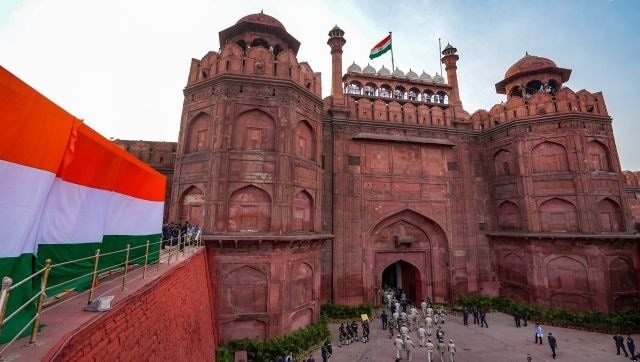Built by the Mughals, how the Red Fort became part of our Independence story
The walls of Red Fort have sustained several attacks and witnessed countless struggles. Significant historical events took place at the 16th-century monument, which has now become synonymous with Independence Day celebrations in New Delhi.
Since 1947, India’s prime ministers have hoisted the tricolour here and addressed the country from the rampart adjacent to Lahore Gate. But why is the iconic site central to our I-Day festivities?
We take a look at the long and storied history of the Red Fort.
The revolt of 1857
Built between 1638 to 1649 by the Mughal emperor Shah Jahan, the Red Fort was not just an architectural marvel – it was the seat of power during the Mughal era. It was after the inauguration of this palace citadel that Delhi became the capital of the empire and remained so until the end of the Mughal rule in 1857.
Initially serving as Shah Jahan’s fort palace, the bastion derived its name from its massive red sandstone walls.
Following Aurangzeb’s reign, the grandiosity of the palace started dwindling as the later Mughal rulers could not take on invaders like Nadir Shah of Iran who looted massive booty from the fort.
Subsequently from mid to late 18th century, attacks from the Marathas, Jats, Sikhs and Gurjars further weakened the Mughal influence on the palace.
By the 19th century, the British expanded their influence in northern India and finally captured Delhi in 1803. Without losing any more time, they started taking control of the Red Fort, knowing well that it was the place which will bring them all kinds of trouble.

In 1857, rebellious sepoys reached the doors of the Red Fort, asking Mughal emperor Bahadur Shah Zafar to lead the mutiny against the British. PTI
And it did. In 1857, rebellious sepoys reached the doors of the Red Fort, asking Mughal emperor Bahadur Shah Zafar to lead the mutiny against the British. Soon, the palace became the central point of the colonial administration’s plan to suppress the rebellion.
The 1857 rebellion was the first major uprising against colonial rule – the Sepoy Mutiny was the first formal war of Independence. It was during this revolt that the Red Fort emerged as an important symbol of the Independence movement since the palace emerged as the foreground of sepoy resistance against Britishers.
After suppressing the rebellion and regaining control over Delhi, the British killed most of Bahadur Shah’s sons and made the emperor a prison in his own home. But this was not the end of it.
Even after the revolt of 1857, the colonial rulers destroyed the inner structures of the Red Fort. Precious artwork, stones and jewels were looted from the palace and Mughal structures like the harem courts, the royal store rooms and kitchens were vandalised.
Historian KN Panikkar told The Wire that even as a failure, the 1857 revolt served as a source of inspiration for the freedom struggle.
Read all our Independence Day specials here
Nuclear tests, liberalisation and more… The milestones that define India
Why Mahatma Gandhi skipped Independence Day celebrations
A look back at the gritty women who fought during the freedom struggle
How ‘Jana Gana Mana’ was adopted as India’s national anthem
Why the Tricolour is hoisted on Independence Day but unfurled on Republic Day
Why is kite-flying such a big tradition on Independence Day?
How Mahatma Gandhi used khadi to fight the British
How India’s freedom struggle influenced political movements across the world
Indian National Army and Red Fort
The infamous Indian National Army (INA) trials brought back the spotlight on Red Fort.
According to Amar Farooqui, a historian and the author of Zafar and The Raj, Subhas Chandra Bose, who headed INA, invoked the Red Fort in his famous call Challo Dilli, according to a report in The Wire. Bose or ‘Netaji’, as he was famously called, said, “Our task will not end until our surviving heroes hold the victory parade on the graveyard of the British Empire, at the Lal Quila, the Red Fort of ancient Delhi.”

From 1945 to 1946, Red Fort was chosen as the location to conduct the court martial of three officers of the INA – Shah Nawaz Khan, Prem Sehgal and Gurbaksh Singh Dhillon. According to a report in The Print, the officers were charged for “waging a war against the king” as they had changed their allegiance during the Second World War. Initially fighting for the British cause, thousands of Indian officials joined the newly constituted INA and assisted the Japanese to fight the English.
Due to the trials, protests and demonstrations were organised across the country. These agitations further solidified the Indian Independence movement.
The nationwide campaign that was waged for the release of the officers further reinforced the public perception of the Red Fort as a symbol of anti-colonial resistance.
A legacy left behind by Nehru
Finally in 1947, as India’s first prime Jawaharlal Nehru replaced the colonial flag with the Indian National flag, the Red Fort cemented its place in modern history.
It’s been 75 years. Since then every prime minister has hoisted the national flag here and given a speech from its rampart. It has now become an Independence Day tradition.
Hundreds and thousands of people gathered to hear the country’s first PM speak and celebrate freedom.
With inputs from agencies
from Firstpost India Latest News https://ift.tt/GqXAY4c
FP Explainers
Comments
Post a Comment